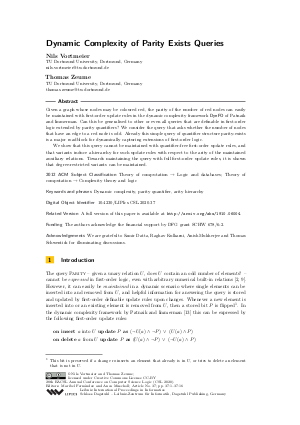@InProceedings{vortmeier_et_al:LIPIcs.CSL.2020.37,
author = {Vortmeier, Nils and Zeume, Thomas},
title = {{Dynamic Complexity of Parity Exists Queries}},
booktitle = {28th EACSL Annual Conference on Computer Science Logic (CSL 2020)},
pages = {37:1--37:16},
series = {Leibniz International Proceedings in Informatics (LIPIcs)},
ISBN = {978-3-95977-132-0},
ISSN = {1868-8969},
year = {2020},
volume = {152},
editor = {Fern\'{a}ndez, Maribel and Muscholl, Anca},
publisher = {Schloss Dagstuhl -- Leibniz-Zentrum f{\"u}r Informatik},
address = {Dagstuhl, Germany},
URL = {https://drops.dagstuhl.de/entities/document/10.4230/LIPIcs.CSL.2020.37},
URN = {urn:nbn:de:0030-drops-116805},
doi = {10.4230/LIPIcs.CSL.2020.37},
annote = {Keywords: Dynamic complexity, parity quantifier, arity hierarchy}
}

 Creative Commons Attribution 3.0 Unported license
Creative Commons Attribution 3.0 Unported license


